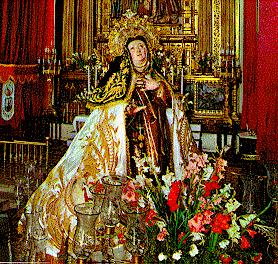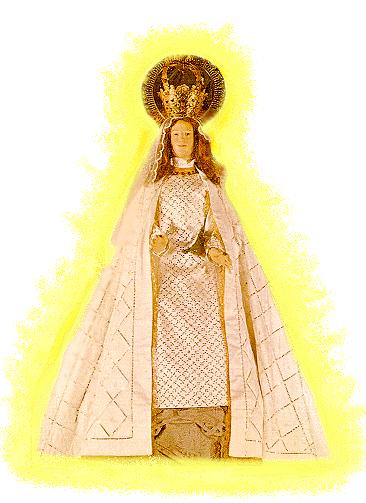 a large statue of her lives usually, and lived when I first saw it, in the church
of the Convento de Santa Teresa, in a gilded baroque chapel built directly over her birthplace. Well, maybe
over her birthplace! I don't know how they define this, since she was actually born at her mother's family
farm nearby but surely not within the walls, although this would indeed have been her father's house
(nothing is left of it). A few days before her feast day, the statue, lifesize (or overlifesize) is brought out into
the church and mounted on a catafalque, massed with flowers and surrounded with electric candelabra.
a large statue of her lives usually, and lived when I first saw it, in the church
of the Convento de Santa Teresa, in a gilded baroque chapel built directly over her birthplace. Well, maybe
over her birthplace! I don't know how they define this, since she was actually born at her mother's family
farm nearby but surely not within the walls, although this would indeed have been her father's house
(nothing is left of it). A few days before her feast day, the statue, lifesize (or overlifesize) is brought out into
the church and mounted on a catafalque, massed with flowers and surrounded with electric candelabra.  The crowd empties out into the plaza, slowly, not fast enough for a white haired priest
in brown wool cassock and white cloak who paces back and forth in front of the door crying
"¡Venga, venga!" and waving people out the doors and aside, making room.
The crowd empties out into the plaza, slowly, not fast enough for a white haired priest
in brown wool cassock and white cloak who paces back and forth in front of the door crying
"¡Venga, venga!" and waving people out the doors and aside, making room.  The little bell rings, she dips, a prayer
is spoken or sung to the accompaniment of the people in the street, the bell rings again, and la Santa
lumbers onward. She's walking to the thirteenth century Catedral, the oldest gothic building in the Iberian
peninsula, whose apse presses a curving bulge into la Muralla as if it has backed up into the walls like a
ship and they stretched before the bulk came to rest.
The little bell rings, she dips, a prayer
is spoken or sung to the accompaniment of the people in the street, the bell rings again, and la Santa
lumbers onward. She's walking to the thirteenth century Catedral, the oldest gothic building in the Iberian
peninsula, whose apse presses a curving bulge into la Muralla as if it has backed up into the walls like a
ship and they stretched before the bulk came to rest.
![]()
 The next day, October 15, is the most important. Two marching bands wait in the plaza in front of the
catedral, one in blue uniform, one in the olive green of the Guardia Civil. These guys look very serious.
The catedral is jammed, there's a flood of people around the tiny Virgin and the zaftig Santa, and the big
guns are assembling at the altar for the formal festival mass honoring a patron saint of Spain and Doctor
of the Church. Three of the big guns are gripped by the barrel, butt down, by young G.C.'s, in dress uniform,
one female, who stand at absolutely rigid parade rest beside the altar, throughout the ceremony and the
long, droning honorific sermon. Clumped inside near the entrance of the catedral are members of the town's
several lay religious societies, each with a satin embroidered banner, each with a different design. The
women in one small group wear identical smart black suits with short skirts, black stockings and heels,
elaborate tall black combs and long black lace mantillas, tied in a knot behind the comb and flowing down
the back.
The next day, October 15, is the most important. Two marching bands wait in the plaza in front of the
catedral, one in blue uniform, one in the olive green of the Guardia Civil. These guys look very serious.
The catedral is jammed, there's a flood of people around the tiny Virgin and the zaftig Santa, and the big
guns are assembling at the altar for the formal festival mass honoring a patron saint of Spain and Doctor
of the Church. Three of the big guns are gripped by the barrel, butt down, by young G.C.'s, in dress uniform,
one female, who stand at absolutely rigid parade rest beside the altar, throughout the ceremony and the
long, droning honorific sermon. Clumped inside near the entrance of the catedral are members of the town's
several lay religious societies, each with a satin embroidered banner, each with a different design. The
women in one small group wear identical smart black suits with short skirts, black stockings and heels,
elaborate tall black combs and long black lace mantillas, tied in a knot behind the comb and flowing down
the back.
![]() When the mass is over, celebrants stream into the plaza to await the appearance once more of la Santa,
who will be accompanied by la Virgen, back to el Convento de Santa Teresa via a more complicated
ceremonial route, outside the walls, around the Plaza de Santa Teresa and within the walls again. As we
come into the sunlight of the plaza, we see the bobbing backs of the Gigantes
(ten foot tall papier machê
costumed stiltwalkers, a Caballero, a Campesiña in embroidered mantilla, a Priest and a Moor) who lead
all Spanish processions. Next come the lay societies, who have organized themselves in order inside the
catedral, and now process towards la Muralla, holding their banners aloft.
When the mass is over, celebrants stream into the plaza to await the appearance once more of la Santa,
who will be accompanied by la Virgen, back to el Convento de Santa Teresa via a more complicated
ceremonial route, outside the walls, around the Plaza de Santa Teresa and within the walls again. As we
come into the sunlight of the plaza, we see the bobbing backs of the Gigantes
(ten foot tall papier machê
costumed stiltwalkers, a Caballero, a Campesiña in embroidered mantilla, a Priest and a Moor) who lead
all Spanish processions. Next come the lay societies, who have organized themselves in order inside the
catedral, and now process towards la Muralla, holding their banners aloft.
![]() The blue uniformed band members fidget, and laugh, testing their instruments; the Guardia Civil stand like
statues. A third marching band of local youth, boys and girls, stand solemnly in neat black uniforms. I've
heard them practice with trap drums and bleating brass beneath my crenellated section of the walls after
dark for more than a week. They never seemed to get better, but I never heard more unique, and I assume,
uniquely Spanish, music.
The blue uniformed band members fidget, and laugh, testing their instruments; the Guardia Civil stand like
statues. A third marching band of local youth, boys and girls, stand solemnly in neat black uniforms. I've
heard them practice with trap drums and bleating brass beneath my crenellated section of the walls after
dark for more than a week. They never seemed to get better, but I never heard more unique, and I assume,
uniquely Spanish, music.

![]() La Santa finally looms out of the darkness of the catedral. Fanfares sound, and she is applauded as she
passes majestically through the door and sweeps through the plaza, around the catedral and beyond la
Muralla, her eyes always on Heaven but never missing a step.
The diminutive Virgen emerges daintily and
receives her applause humbly and graciously, the gold embroidery on her white gown and cape glittering
in the sun.
La Santa finally looms out of the darkness of the catedral. Fanfares sound, and she is applauded as she
passes majestically through the door and sweeps through the plaza, around the catedral and beyond la
Muralla, her eyes always on Heaven but never missing a step.
The diminutive Virgen emerges daintily and
receives her applause humbly and graciously, the gold embroidery on her white gown and cape glittering
in the sun.
![]() We sidestep and head for the portal they will use to re-enter la Muralla. The streets are already jammed
with people who have taken up their chosen positions along the route of the procession. Outside the portal
we choose a place that will allow us to see the procession coming and going, around the Plaza de Santa
Teresa and into the portal. This is one of my favorite places, with a view to the razor toothed mountains to
the south, and right in front of a massive marble statue of la Santa, the one I like the most. She is seated,
pausing in the midst of writing, listening to divine inspiration,
one hand open on her lap. A fresh rose or gladiolus or carnation has rested in her hand every day since
I've arrived, and since last night la Santa
has been engulfed in affectionate floral offerings from the whole city : businesses, societies, congregations,
the police.
We sidestep and head for the portal they will use to re-enter la Muralla. The streets are already jammed
with people who have taken up their chosen positions along the route of the procession. Outside the portal
we choose a place that will allow us to see the procession coming and going, around the Plaza de Santa
Teresa and into the portal. This is one of my favorite places, with a view to the razor toothed mountains to
the south, and right in front of a massive marble statue of la Santa, the one I like the most. She is seated,
pausing in the midst of writing, listening to divine inspiration,
one hand open on her lap. A fresh rose or gladiolus or carnation has rested in her hand every day since
I've arrived, and since last night la Santa
has been engulfed in affectionate floral offerings from the whole city : businesses, societies, congregations,
the police.
 Chapter Three: La Fiesta de Santa Teresa
Chapter Three: La Fiesta de Santa Teresa